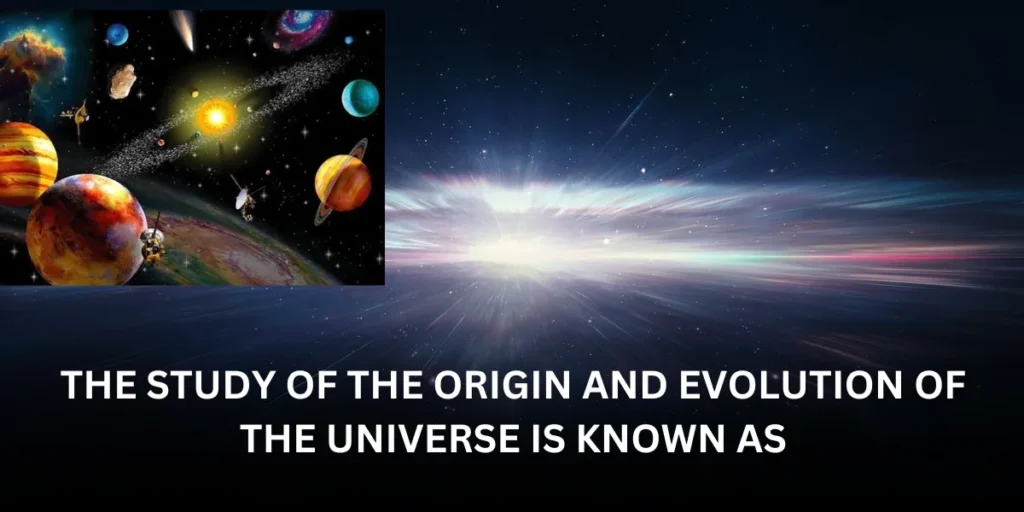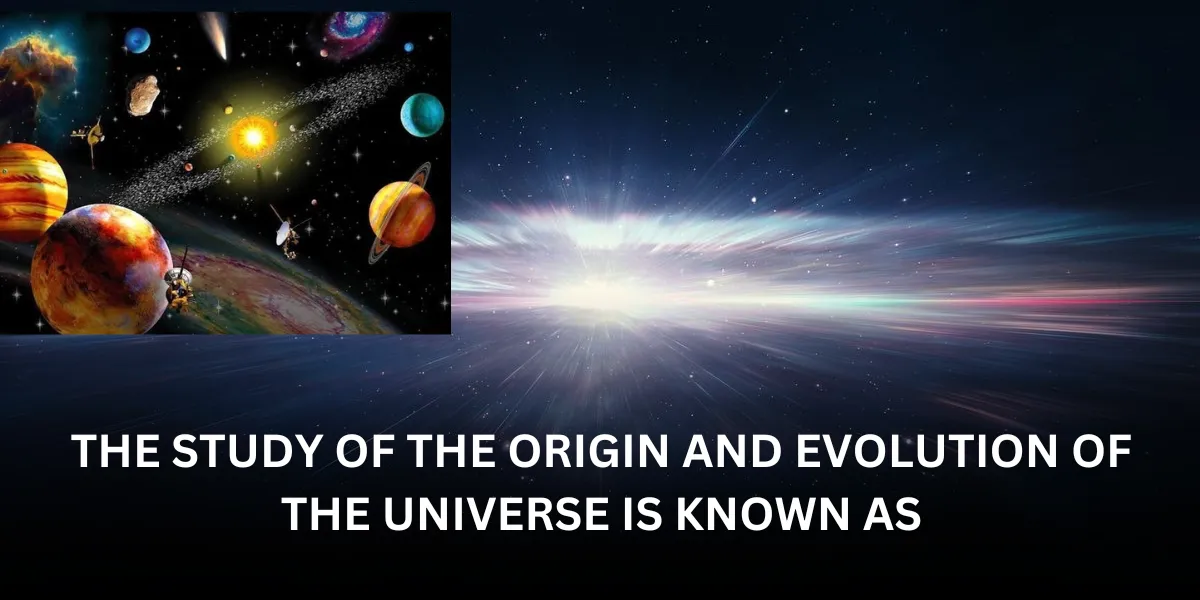the study of the origin and evolution of the universe is known as The Study of the Origin and Evolution of the Universe is Known As Cosmology Cosmology is the study of the universe’s creation and development. This exciting area of astronomy studies the vastness of space and time, from the beginning of the universe to its final destiny. Cosmologists solve cosmic riddles and provide light on the origins and composition of the universe by observing far-off galaxies, cosmic microwave background radiation, and other phenomena.
1. Introduction to Cosmology
the study of the origin and evolution of the universe is known as Have you ever pondered where everything comes from when you look up at the night sky? These important concerns are addressed by cosmology, the study of the universe’s creation and evolution. To investigate the most fundamental aspects of the universe, this scientific field combines modern tools, theoretical physics, and observations. Come explore the fascinating field of cosmology and learn how it aids in our understanding of the universe.

2. The Birth of the Universe: The Big Bang Theory
The Big Bang Theory is one of the most extensively recognized theories regarding the universe’s beginnings. This theory states that 13.8 billion years ago, the study of the origin and evolution of the universe is known as the universe was a point that was extremely hot and dense. Then, in a massive explosion, this original singularity swiftly expanded, giving rise to all matter and energy that exist today. But what proof is there for this dramatic start?
3. Evidence Supporting the Big Bang Theory
The Big Bang Theory is backed by several key pieces of evidence:
- Redshift of Galaxies:The cosmos is expanding, according to Edwin Hubble’s observation that galaxies are veering away from us.
- Cosmic Microwave Background Radiation: This faint glow, which was found by Robert Wilson and Arno Penzias, is a relic from the Big Bang that permeates the entire cosmos..
- Abundance of Light Elements: The amounts of lithium, helium, and hydrogen that are projected for the universe match those that were created in the first few minutes following the Big Bang.
Together, these findings support the Big Bang Theory and depict a dynamic, ever-evolving universe.
4. The Cosmic Microwave Background Radiation
Imagine a cosmic echo that dates back to the beginning of time and is still audible today. That is the Cosmic Microwave Background (CMB) Radiation. This radiation represents the remnants of the Big Bang, offering an image of the cosmos at 380,000 years old. Through the analysis of the CMB, cosmologists can learn more about the conditions, makeup, and structure of the early cosmos.
5. The Expanding Universe
One of the most intriguing discoveries in cosmology is that the universe is expanding. This expansion means that galaxies are continuously moving away from each other. Think of it like dots on the surface of an inflating balloon— as the balloon expands, the dots move further apart. This observation has profound implications for understanding the universe’s past and future.
6. Dark Matter and Dark Energy
Dark matter and dark energy make up a sizable fraction of the cosmos, despite the fact that everything we see is made of regular matter. Despite being invisible, dark matter has a gravitational pull that affects how galaxies develop and behave. the study of the origin and evolution of the universe is known as On the other hand, the universe’s fast expansion is believed to be caused by dark energy. Combined, these enigmatic elements make up around 95% of the mass-energy content of the universe.
7. The Formation of Galaxies and Stars
Massive clouds of gas and dark matter gave rise to the universe’s great structures, known as galaxies. Stars were created as a result of these components being drawn together over time by gravitational forces. Galaxies were formed by the clustering of stars. We can follow the evolution of the universe from its chaotic origins to its current complexity by comprehending the formation processes of galaxies and stars.
8. The Role of Gravity in Cosmic Evolution
One of the universe’s architects is gravity. Stars, galaxies, and even bigger structures like galaxy clusters are shaped by it. This basic force drives the dynamic processes that have shaped the universe over billions of years and controls the motions of celestial bodies. The universe as we know it would not exist without gravity.
9. The Life Cycle of Stars
Stars go through a dramatic cosmic cycle of birth, life, and death. Their lives start in gas and dust clouds known as stellar nurseries. Stars glow for millions or billions of years through nuclear fusion. Stars experience drastic changes when their fuel runs out. Depending on their mass, some explode as supernovae, while others change into white dwarfs, neutron stars, or black holes.
10. Black Holes and Their Mysteries
One of the universe’s most mysterious objects are black holes. These areas of spacetime, formed from the remnants of enormous stars, have such a tremendous gravitational pull that nothing can escape from them, not even light. Our knowledge of physics is put to the test by black holes, particularly near their singularities where conventional laws fail. By examining them, mysteries regarding the underlying structure of reality can be revealed.
11. The Ultimate Fate of the Universe / the study of the origin and evolution of the universe is known as
What does the universe have in store? Diverse ideas put out various scenarios regarding its eventual destiny. According to the Big Freeze theory, the cosmos will keep expanding and then progressively chill down to reach maximum entropy. On the other hand, the Big Crunch theory suggests that gravitational pull might someday stop the cosmos from expanding and bring it back to a singularity. An further scenario is the Big Rip, where the effect of dark energy has the potential to destroy all matter. Every scenario is a reflection of the continuous effort to determine the long-term fate of the universe.
12. Tools and Techniques in Cosmological Research
Technology has transformed the field of cosmology. We can see a great distance into the cosmos thanks to telescopes, both on the ground and in orbit. The secrets of the cosmos are revealed by instruments such as the Hubble Space Telescope and the James Webb Space Telescope, which gather amazing photos and data. Furthermore, cosmologists evaluate theories and forecast cosmic events with the use of theoretical models and computer simulations.
13. Key Figures in the History of Cosmology
Brilliant minds have shaped our quest toward understanding the universe. Albert Einstein’s general theory of relativity dramatically changed our thinking. The expanding universe was discovered by Edwin Hubble. Stephen Hawking made revolutionary advances in the physics of black holes. Generations of scientists have been inspired to study the cosmos by these and other pioneers who cleared the path for modern cosmology.
14. Cosmology and Philosophy: The Big Questions
the study of the origin and evolution of the universe is known as Cosmology addresses important philosophical issues in addition to statistics and data. What is existence’s nature? Exist more than one universe? What caused the cosmos to exist? Philosophical in nature, these queries provoke us to consider the essence of reality and our place in the universe.
15. Conclusion: The Ever-Evolving Field of Cosmology
the study of the origin and evolution of the universe is known as Cosmology, the study of the universe’s creation and development, is still fascinating and motivating. There is always more to learn and fresh discoveries to be made. Cosmology unveils the wonder and intricacy of the cosmos, spanning from the formation of stars to the enigmas surrounding dark matter. It’s an adventure that tests the limits of human curiosity and understanding, serving as a constant reminder that there is always more to discover about the universe.
FAQ
1. What is Big Bang theory defined as?
The most popular theory to explain how the cosmos came into being is the Big Bang Theory. According to this theory, the cosmos started out as a hot, dense point 13.8 billion years ago and has been growing ever since.
2. What does dark matter entail?
Dark matter is a class of stuff that is invisible because it is incapable of emitting, absorbing, or reflecting light. It is thought to make up around 27 percent of the cosmos and interacts with ordinary stuff through gravity.
3. How is the expansion of the cosmos known to us?
Thanks to observations of redshift in the light from far-off galaxies, we are aware that the universe is expanding. As a result of galaxies moving away from us, this redshift suggests that space is expanding.
4. What do you know about black holes?
Spacetime black holes are places where gravity is so powerful that nothing can escape from them—not even light. They are created when enormous stars collapse due to gravity and leave behind their remnants.
5. What will be the universe’s final fate?
It is still unclear what will happen to the universe in the end. A few possible outcomes are the Big Freeze, in which the universe keeps expanding and cooling, the Big Crunch, in which it breaks apart due to dark energy, and the Big Rip, in which it collapses back into a singularity.

